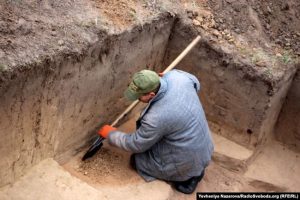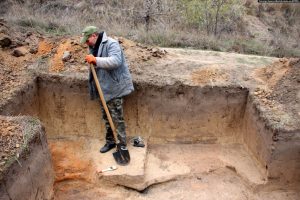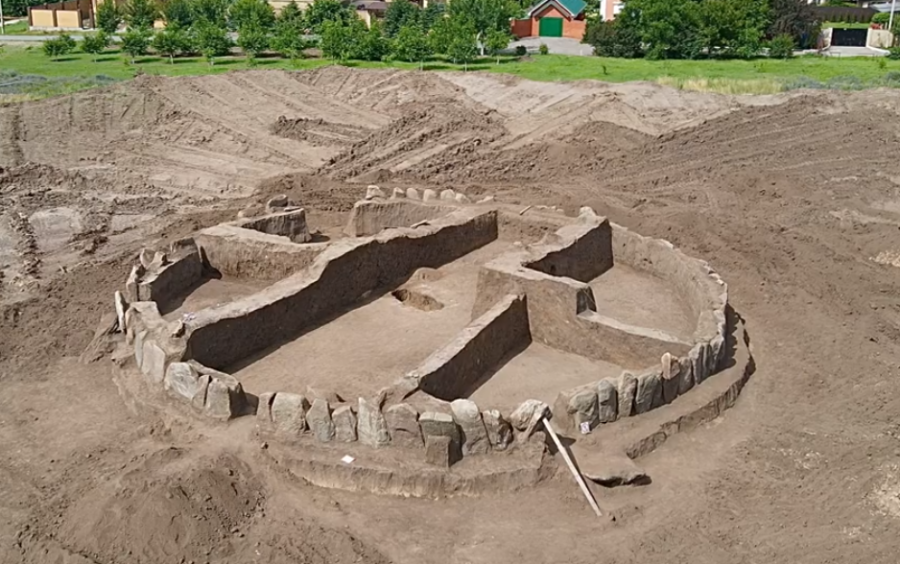This is the first Cossack cantonment to be discovered on Khortytsia in 30 years.
“Here we can see the upper layers covered with soot, which indicates a fire was lit in the quarters. A piece of the oven remains. There was probably a dome over it; it had a hemispherical shape. There were two ovens, which is unusual for such a small room. This suggests that most likely it was not a residential, but some kind of general utility room. Either the Cossacks burned coal here, or it was some kind of field kitchen, or a place to make saltpeter. We’re quite sure the Cossacks were producing something here,” says Dmytro Kobaliya, Candidate of Historical Sciences, head of the Khortytsia National Reserve’s Monument Protection Department.

The archaeologists came across these quarters at the end of the archeological season, although they have been working for months with the Department of Culture and Tourism of the Zaporizhzhia City Council to search for the remains of Cossack cantonments on Khortytsia Island.
“Cantonments were usually located in a “balka”, a kind of natural gully or ravine, which bore the name of the Cossack who resided there. For example, Kostin or Hromushyn balkas, both of which are situated on Khortytsia. We’re standing in Sovutyn balka, which was home to Cossack Sovut. This year, we decided to look for these cantonments, and it was only now that we were lucky enough to come across this site,” says Dmytro Kobaliya.
It’s been thirty years since the last discovery of a Cossack cantonment, and the artefacts unearthed by the diggers will not impress average people, but they represent a goldmine for researchers and archaeologists.
“Several small, lead pellets and fragments of two glass vessels were found, and they will enable us to date the finds. We also found a metal plate, typical of the 18th century, so we can assume that this chamber dates back to the 18th century. The findings indicate that the people who lived here had weapons, because there were bullets and pellets, which they needed to survive in this dangerous environment. We also dug up remains of some utensils, but very few, which suggests that people didn’t live here, but somewhere nearby. This place was probably used for some kind of production,” explains Dmytro Kobaliya.

The Khortytsia National Reserve has explored the neighbouring area and has identified several other structures near this outbuilding. Dmytro Kobaliya believes that there are ten to twelve other structures nearby and hopes to further explore the area in the coming years.
What is a Cossack cantonment?
Dmytro Kobaliya explains that a cantonment (Ukrainian: “зимівник ») is a small hamlet inhabited by several Cossacks, who were mainly engaged in farming, fishing, hunting and crafts, all of which constituted the foundation for the economy of Zaporizhzhian Sich. There were about 17, or maybe even more, cantonments spread across the whole island of Khortytsia.

Most of the Zaporizhzhian Cossacks lived in such encampments, and could easily and quickly gather their belongings and move to another area.
“In the North, Cossacks created small farmsteads where they raised their families. But, it was more difficult to sustain a family in the South. So these encampments were constructed… and they were convenient and easy to manage. The Cossacks could pack their belongings and move quickly to another balka if so required.
There were a lot of them in the 18th century. Not just a few, but hundreds – there was a whole network of small homesteads that were interconnected and interacted with one other. They also fed the main fortress – the Sich. Here, these Cossacks were engaged in household matters and, of course, they also participated in campaigns. Most Cossacks lived in villages or such cantonments, and only a small group of professional soldiers, who were not engaged in agriculture, lived in the Sich,” says Dmytro Kobaliya.

The concept of Cossack cantonments has been known and studied since the 15th century, says Oleksandr Oliynyk, historian of Zaporizhzhian Sich, Candidate of Historical Sciences, and Director of the Business and Food Technology College, who has been studying the socio-economic history of 18th century Cossack encampments for over 20 years.
“The first mention of cantonments can be found in a documents by Stephen Báthory (Voivode and Prince of Transylvania, King of Poland and Grand Duke of Lithuania-Ed), who mentions that Cossacks cantonments were scattered all across the territory, as far as the Don River. Therefore, it’s more than likely that they appeared at the same time as the first Cossack units and constitute the oldest Cossack institutions, the basis for their economic activity. Of course, over time, the encampments changed, as did Zaporizhzhian society, Zaporizhzhian Sich and other administrative centres,” explains Oleksandr Oliynyk.
Eventually, such encampments were turned into farms. Unlike the neighbouring territories of the Russian Empire, in the 18th century, the Cossacks adopted a capitalist model. The cantonments were run by the Cossacks themselves, who often hired outside workers to help run the homesteads.
“Cantonments were turned into what we now call “farms”, which were very diversified. Towards the end of Zaporizhzhian history, in the 18th century, there were more than 9,000 cantonments. That’s the number I recorded in my 2008 monograph. A kind of capitalism reigned in Cossack society. There was no serfdom, no humiliation. People were hired and worked under contract. Meanwhile, serfdom continued in the Russian Empire, where capitalism appeared much later. Moreover, no one, even among the Cossacks, could be called poor or badly dressed. Such individuals were ridiculed and put in their place,” explains Oleksandr Oliynyk.

Oleksandr Oliynyk adds that this information is confirmed in archival documents of the garrison of the Zaporizhzhian Lowland Army, which, unfortunately, was not completely preserved. These documents clearly describe Cossack cantonments, which brought huge profits to Cossack officers. We know that the Cossacks were quite wealthy, as so many stories and legends recount how widely and confidently they lent money. When the Sich and the Zaporizhzhian encampments were liquidated in 1775, Moscow’s property assessors were surprised that the Cossacks could not name the exact number of cattle they owned.
How the Cossack cantonment concept changes the perception of the history of southern Ukraine
Never-ending, wild fields, untamed wasteland – such descriptions of the South of Ukraine can be found in historical publications of the Russian Empire and the Soviet Union. The authors of such publications maintain that settlements and urban centres appeared in southern Ukraine thanks to the Russian Empire. However, archaeological findings, similar to those on Khortytsia Island, demonstrate that such claims are not at all justified, say historians of Zaporizhzhian Sich.
“Our findings radically change the stereotypes instilled and spread by the Soviet regime. Cossacks were generally considered to be swashbucklers, drunkards, idlers, thieves, etc. However, each social entity must have an economic basis. Cantonments constituted this economic basis of Zaporizhzhian society, the Zaporizhzhian Free Lands, and their domains, whose territories were as large as modern Moldova or modern Denmark. In other words, stories about the “wild fields” and “Potemkin villages” of the South were just delusional stories fed to Ukrainians by Russian propaganda. These territories were always populated by an indigenous population and the Cossacks,” underlines Oleksandr Oliynyk.

Most settlements in southern Ukraine appeared in places populated by Zaporizhzhian cantonments. These include the city of Zaporizhzhia, whose founding date is usually associated with the construction by the Russian Empire of the Oleksandrivsk Fortress in 1770. It was erected as part of the Dnipro Defence Line to protect the southern territories of the Russian Empire from Crimean Tatar invasions.
“This area was urbanized about 250 years ago. There were many cantonments on the territory of the city of Zaporizhzhia. The area of the Oleksandrivsk Fortress alone had ten of them! Over hundreds of years, the Cossacks had worked these lands, establishing their encampments along the rivers, gullies, ravines, valleys… wherever it was convenient to run their farms. There’s even a popular saying: ‘there’s a Cossack in every gully!’
When the fortress was built, the Cossacks were away at war, and their encampments were quickly dismantled and destroyed. This is a historical fact related to Russian expansion and military conquest.” says historian Oleksandr Oliynyk.

The history of Cossack cantonments is not only about the economy and settlement of southern Ukraine, but also about the mentality and temperament of Ukrainians.
“This page of Cossack history largely explains why we, Ukrainians, are so independent and like to make decisions on our own. In contrast to Russia, where a strong patriarchal system exists, where everything is decided by the head of the family, Ukrainians want to make their own decisions, independently, like the Cossacks who lived freely on such small homesteads. When necessary, they united, took part in campaigns, returned home and lived independently in their cantonment,” concludes Dmytro Kobaliya.








